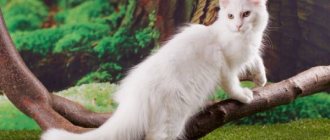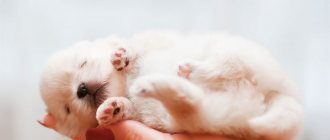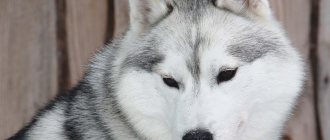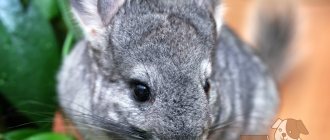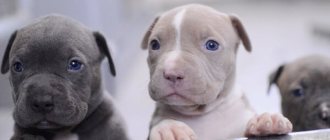- home
- Chinchilla
- Character and features
04/04/2019 The chinchilla is a beautiful and incredibly cute animal that has become popular for home breeding. The most important indicators of health and proper development are the size and weight of the chinchilla. Zoologists have determined the average parameters of the animal, which can be used as a guide during different periods of its life.
Adult chinchilla size
At the same age, chinchilla sizes may vary depending on:
- gender;
- genetic characteristics;
- health conditions;
- living conditions.
An animal kept in pairs is larger in size than one raised alone.
The size of an adult female specimen exceeds that of a male. For different specimens, the body length ranges from 22 to 38 cm, the tail grows from 8-10 to 15-17 cm.
Interesting Facts
- Chinchillas are perhaps the only animals whose life expectancy in captivity is shorter than in their natural habitat.
- To ensure that pets are properly cared for and fed, pet owners usually try to match the animal's life stages to the human life stages. There is no single formula that will determine the age of a chinchilla by human standards. It is generally accepted that the age of 1 month in rodents corresponds to 6 months in humans, 6 months - 14-16 years, 10-12 years - 40-45 years, and 20 years - 75 years.
- The beauty of chinchilla fur prompted breeders to develop new species of other animals with similar fur. This is how the breed of chinchilla rabbits and British chinchilla cats appeared.
- Chinchillas do not shed in the usual sense of the word. A complete change of coat occurs once in young individuals; subsequently, the coat is renewed daily by the loss of some of the old hairs.
Chinchilla weight
An adult female weighs on average 500-650 grams, but can reach 800. There are known cases when a female had a kilogram mass. Males are smaller in size and weight than females. Their average weight is from 450 to 600 grams. Even large individuals usually do not exceed 700 grams.
Owners of pets whose size and weight deviate from the average in one direction or another should especially carefully monitor the well-being of the animal. If he has a good appetite and is at the same time mobile and active, then there is nothing to worry about.
If, after mating, an adult female chinchilla suddenly gains weight, this may be a sign of pregnancy. After mating, it is recommended to weigh the animal regularly. This will help you notice deviations in the condition of the female and her offspring in time and take the necessary measures.
If in infancy and childhood rodents gain weight evenly, this means that they receive in sufficient quantities everything they need for development. Starting from one and a half years, any weight fluctuations should be alarming. In the absence of pregnancy, the reasons may be either illness or non-compliance with the conditions of keeping the mammal.
Description of the animal
Chinchillas are school animals. They form groups, the number of which can reach several dozen individuals. Each colony has an individual, usually a female, who monitors the habitat of the flock and gives a signal in case of danger.
Rodents are nocturnal. They have well-developed hearing and vision; orientation in the dark is also provided by vibrissae; their length can reach 10 cm.
The sounds that chinchillas make depend on the condition of the animal:
- to communicate with other individuals or attract attention, animals make sounds reminiscent of cooing or grumbling;
- short and smooth sounds are a call for mating;
- if a rodent gets angry or shows dissatisfaction, it grinds its teeth;
- a sharp and short squeak is a sign of fear or approaching danger.
Due to the small number of chinchillas in nature and their nocturnal lifestyle, most information about the rodent was obtained based on observations of individuals kept in captivity.
What sounds does a chinchilla make?
What does it look like
The appearance of a chinchilla has the following features:
- the body and head are rounded and slightly elongated, the neck is short;
- the ears are round, there are membranes inside the auricles that cover the hearing aid while taking sand baths;
- the front legs have four grasping fingers, the hind legs are longer, thanks to which the animal is able to jump far and develop high speed;
- There are 20 teeth in the oral cavity, 4 of which are incisors; they grow throughout life and need constant grinding.
The average size of an adult chinchilla is in the range of 22-30 cm, and its weight is 700-800 g. Tail length is from 70 to 17 cm. The largest chinchilla can reach sizes of 35-38 cm and weight up to 1 kg.
How to distinguish a female from a male
Sexual dimorphism in chinchillas is practically not expressed in appearance: individuals of both sexes have the same size and color and differ slightly in size (females are larger). The only difference that makes it possible to accurately determine gender is the structure of the genital organs.
To determine the sex of the animal, you need to pick it up, lift its tail and estimate the distance between the anus and the protruding tip. In the female they are located nearby, and in the male they are located at a short distance.
Chinchilla fur
The special properties of the rodent's coat are provided by the unusual structure of the hair follicles, each of which contains from 60 to 80 villi, while the guard hairs found in other animals are completely absent.
Thanks to such dense fur, chinchillas are able to live in cold mountain climates, where temperatures drop to -30 degrees. Due to the high density of villi, they do not have ectoparasites.
Since this type of rodent lacks sebaceous and sweat glands, their fur is not protected from moisture. To dry the coat and remove dead hairs and dirt, the chinchilla bathes in fine dust or sand.
In terms of softness and density of fur, the chinchilla surpasses all wild mammals. Animal skins were used to make clothing items by the ancient Indians. At the same time, chinchilla fur was considered a luxury, available only to leaders and other titled members of the tribes, and the capture of animals was limited.
With the advent of Spanish settlers in South America, mass trapping of rodents began in order to obtain skins for export to Europe. Commercial hunting has become so widespread that a new profession has emerged in Chile: “chinchillero” (chinchilla hunter).
It is impossible to establish exactly how many animals were exterminated before the complete ban on hunting in 1929. According to surviving data on legal exports, more than 7 million chinchilla skins were exported to Europe from 1840 to 1916 alone.
Among the most expensive furs in the world, chinchilla ranks fourth.
COMMON BEAVER
Weight of cubs from birth to month
Unlike other rodents, chinchilla puppies are born with fur, teeth and sight. Already at the age of a week they are able to feed on their own.
Newly born babies look like fluffy balls weighing only 30-50 grams. The initial parameters of the animals are influenced by:
- parents' sizes;
- number of puppies in the litter;
- the course of pregnancy in a female.
There are newborns weighing up to 70 grams. But it is not at all necessary that such a cub will become a very large individual.
However, when purchasing a chinchilla, ask about its parameters at birth, as well as what type of puppy it was born with. As a rule, the first puppies in a litter are larger than the last. In the future, these data will help assess the baby’s development.
The lactation period in chinchillas lasts from 45 to 60 days. On the first day, the cubs can lose up to 2 grams of weight. From the second day they have been gaining it steadily. Chinchillas grow quite quickly. After a month, the animals are almost three times heavier than on the first day.
Table of body weight gain in the first month of life for puppies
| Age (days) | Weight (grams) | Age (days) | Weight (grams) | Age (days) | Weight (grams) |
| 1 | 30-50 | 11 | 50-75 | 21 | 76-104 |
| 2 | 31-52 | 12 | 52-77 | 22 | 78-107 |
| 3 | 33-54 | 13 | 55-80 | 23 | 80-110 |
| 4 | 35-56 | 14 | 58-83 | 24 | 83-113 |
| 5 | 36-59 | 15 | 61-86 | 25 | 87-117 |
| 6 | 38-61 | 16 | 63-89 | 26 | 90-121 |
| 7 | 40-63 | 17 | 66-92 | 27 | 93-125 |
| 8 | 42-66 | 18 | 68-95 | 28 | 96-129 |
| 9 | 45-69 | 19 | 71-98 | 29 | 100-133 |
| 10 | 47-72 | 20 | 73-101 | 30 | 103-137 |
The daily increase in the first week does not exceed one and a half grams. It increases noticeably during the second week and amounts to 2-3 grams per day. And from the 24th day of life, babies gain 3-4 grams daily. If the puppies are gaining weight well, it means they have enough milk. If this indicator is significantly lower than normal and upon examination of the female it turns out that she has no milk, the babies are placed with a wet nurse. If this is not possible, they are fed artificially. In this case, during the first week, the cubs are given a special mixture at least every 2.5-3 hours.
By comparing the size and weight of a chinchilla by month with the average parameters, you can understand whether it is developing correctly.
Zoologists suggest focusing on average data. A chinchilla should weigh:
- at the end of the first month about or slightly more than 113 grams,
- at the end of the second - 242,
- at the end of the third - 327,
- fourth - 385 grams,
- sixth - 475,
- at the end of the eighth - 506 grams.
By ten months, the animal reaches a weight of approximately 600 g. By one year, chinchillas usually have the size of an adult animal. But some individuals still continue to grow up to one and a half years. Uniform development of the animal is rare, but with proper care the final indicators will be close to normal.
Deviations from the norm
Quite often, chinchilla owners are faced with the fact that their pets do not fit into established standards. This can happen both for understandable physiological reasons and in connection with certain pathologies. Most often, furry cats suffer from increased weight, and this happens in the following cases:
- Poor nutrition . Chinchillas are herbivores. In the wild, 90% of their diet consists of dry grass, mosses and lichens. Therefore, at home they need to be fed similar food. But many owners, in their desire to pamper their pet, literally feed the animal with sweet fruits, dried fruits, and nuts. Or even worse - sweets, salted seeds and chips. Such a menu will inevitably lead to obesity of the animal with all the ensuing consequences.
- Diseases . Excess weight in a chinchilla can appear against the background of diabetes and other hormonal imbalances, metabolic disorders, and the formation of benign and malignant tumors. Therefore, if, after gaining excess weight, the fluffy dog has become apathetic, exhibits unreasonable anxiety, and does not eat well, it is necessary to urgently take him to the veterinarian.
- Pregnancy . Rapid weight gain is considered normal for pregnant females. Indeed, in addition to the fact that the chinchilla is gaining weight due to the growing babies, during this period it needs to be fed with more high-calorie food. The female needs additional energy in order to remove the load on the body and have the strength to give birth and feed the offspring.
It is worth noting that sometimes chinchillas suffer from underweight. This can happen for various reasons:
- poor nutrition, lack of vitamins, micro- and macroelements;
- thyroid diseases;
- worms and other endoparasites;
- frequent stress;
- diseases of the digestive system.
If excess or underweight is detected, it is necessary to bring the indicator back to normal as soon as possible, otherwise the consequences can be dire. If you have any doubts about the cause of a deviation from the norm, you should contact a veterinary clinic. A specialist will quickly identify factors that have an adverse effect on your pet and give recommendations on how to eliminate them.
In order not to have to spend a long time treating a chinchilla, it is necessary to constantly monitor its weight and size. Because it is much easier to deal with the problem at the very beginning, before health complications arise. Good physical shape is a sign of a healthy and active pet that will live a long and happy life.
Why does a chinchilla lose weight?
Weight fluctuations in a rodent may indicate health problems or errors in maintenance.
Newborns must be weighed, so it is easy to identify the lack of milk in the mother. If the weight of the entire litter is below normal, it is necessary to supplement the pets artificially. It is better to weigh on a scale with at least 1 gram division. It is enough to do this once every 5-7 days to track the dynamics of indicators.
Adult animals also need to be placed on scales regularly. If weight loss is noticed, the cause may be illness or stress. In this case, weigh your pet every day. If it turns out that he is losing 10 g daily, this will confirm the seriousness of the problem.
Here are several reasons for chinchilla weight loss:
- possible presence of parasites;
- excess physical activity. You can temporarily remove the running wheel from the cage and watch your pet;
- low calorie diet. Try to adjust it;
- complete refusal to eat. In this case, you need to check your teeth.
How to achieve uniform development and growth of your pet?
Chinchillas are herbivores that are quite fastidious about changing their diet. They are quite active and playful, so their diet should be enriched with proteins and carbohydrates. Rodents do not finish old food, and if they don’t like something, the rodent will remain hungry, but will not eat what they don’t like.
List of prohibited products:
1. Pine nuts grains, fried seeds. This food will worsen your digestion. 2. Any prepared food; the chinchilla eats exclusively raw foods. 3. Flour products of any kind. The rodent only approves of crackers made from wheat flour. 4. Chinchilla does not digest rye. 5. Products that have no nutritional value. 6. Monotonous diet. 7. Food from the hosts' table.
If you introduce grains into your diet, they should be of exceptionally high quality. Sometimes you can pamper your beloved pet with dried fruits, rose hips, hawthorn, fresh vegetables and fruits. Chinchillas love apples, carrots, bananas, melon, potatoes, and cabbage. The main part of the diet is hay and slightly dried greens. An abundance of carbohydrates will lead to obesity, so feeding the animal is prohibited.
Chinchilla as a pet: pros and cons
Keeping chinchillas at home has its pros and cons. Let's look at them.
Pros:
- An independent and clean rodent that does not require constant attention, it is an excellent choice for busy people who do not have the opportunity to devote a lot of time to their pet.
- A chinchilla does not produce an unpleasant odor, even if the animal’s cage has not been cleaned for several days. This is due to the absence of sweat and sebaceous glands in the rodent’s body.
- Chinchilla fur does not harbor fleas and ticks.
- Chinchilla fur is hypoallergenic.
- These animals carry out hygienic care on their own, which reduces the list of responsibilities for the owner.
- They have strong immunity and do not suffer from genetic diseases.
- They eat little, so you don’t have to spend a lot of money on food and necessary accessories for your chinchilla.
Minuses:
- are nocturnal;
- afraid of loud sounds;
- can't stand heat;
- walks around the house can only be done under supervision, as a chinchilla can chew furniture and other interior items;
- To keep a rodent, you need a spacious cage with good equipment so that the self-sufficient and active animal always has something to do.
Chinchillas are cute, fluffy animals with interesting behavior patterns that bring their owners a lot of positive emotions.
Rules for caring for a chinchilla at home
Key indicators for keeping chinchillas at home are based on temperature, food and housing for the exotic animal.
Temperature requirements:
- mandatory presence of air conditioning;
- normal temperature - +18 °C;
- if the temperature is allowed to exceed +28 °C, there is a risk of heat stroke and death of the animal.
Video: how to properly care for chinchillas
Principles of a balanced diet:
- food for chinchillas should not be confused with food for other domestic rodents, there is a different ratio of vitamins and minerals;
- feeding once a day, volume - 40 g;
- constant availability of clean drinking water at room temperature;
- mineral fertilizing: chalk and mineral stones;
- twigs of apple and birch - these are vitamins and care for teeth;
- treats: rose hips, raisins, prunes, dried apricots, dried apples, hay. Give once or twice a week.
Content area standards:
- minimum cage dimensions - 50x50 cm;
- metal cage with a retractable bottom;
- the cage is installed in a cool place, there should be no heaters or batteries nearby, no direct sunlight, no drafts;
- the cage must include a drinking bowl, shelves, ladders, wheels, and houses;
- availability of special bathing sand for bathing;
Weighing equipment
There is no need to weigh your chinchilla using expensive scales. Many exotic rodent owners go to their local department store and find a perfect scale in the kitchen section.
Chinchilla on the scales
The scale should be able to switch from ounces to grams. Grams are used when weighing chinchillas because they are smaller. This helps show the change much sooner than a much larger ounce measurement would. If the scale doesn't have a container to put your chinchilla in, a small bowl, box, or cage can be used. A small notepad should be used to record the chinchilla's weight and the date of measurement.
How big are the puppies?
Their weight range is from 25 to 60 grams. This criterion depends on the nutrition of the mother who feeds them with her milk, the conditions in which newborns are kept and the genetic characteristics of the female. A larger female gives birth to larger offspring. If, for example, mother and daughter have the same color, then with a high degree of probability we can expect that the daughter will grow up to be large.
Mature puppies need a lot of fiber to grow and achieve a normal weight; their diet should consist mainly of grass hay and food with a high protein content (25%).
How to weigh
Using a bowl like the one pictured above can help.
keep a young or adult chinchilla on the scale long enough,
to weigh them. First, gather all the equipment before you take your chinchilla out of the cage. The scale should rest on a stable surface such as a countertop or table. As mentioned earlier, if the scale does not have a weighing container, a bowl, box or small cage will do. Turn on the scale, make sure it is set to grams, and then place the container on it. Most scales have a container feature. This allows the user to compensate for the weight of the container. Simply press the tare button while the container is on the scale. Once the scale reads zero with a container on it, place the chinchilla in the container, find the reading and write it down. Some chinchillas actually sit on scales without a container. If the chinchilla wants to sit on the scale, the container and container function are not needed. A small treat given to a chinchilla can keep the chinchilla busy and still be enough to weigh him down. If the scale does not have a container function, weigh the container, then place the chinchilla in it and weigh them together. Subtract the weight of the container from the total weight. The result is the chinchilla's weight.


